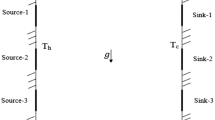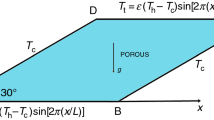Abstract
Numerical simulation of mixed convection and surface radiation in a horizontal rectangular channel with five discrete heat sources protruded from the bottom wall has been carried out. Air is considered as working fluid and flow to be laminar, steady, and incompressible. The parameters varied are Reynolds number (Re) = 100–750, the spanwise position of vortex generator (VG) x/H = 1.8, 2.8, 3.8 4.8 and 5.8, the pitchwise position of VG, y/H = 0.5, 0.6 and 0.7 and emissivity of the heat source, εc = 0.1–0.9, while emissivity of the VG and channel walls is fixed as 0.9. The governing equations are solved based on SIMPLE algorithm using ANSYS 16.2. The results show that the Reynolds number, the position of vortex (spanwise and pitchwise), and emissivity of heat source have significant effects on heat transfer. It is also noticed that the maximum non-dimensional temperature (θmax) is 47.81% with VG at Re = 250 with change in emissivity of the heat sources from 0.1 to 0.9. Finally, a correlation has been developed for average non-dimensional temperature (θavg) using response surface methodology.














Similar content being viewed by others
Abbreviations
- A :
-
Height of the triangular VG (m)
- B :
-
Width of the base of the triangular base (m)
- c p :
-
Specific heat capacity at constant pressure (kJ kg−1 K−1)
- D :
-
Distance between two chips (m)
- \(E_{{\text{k}}}\) :
-
Emissive power of surface k
- \(F_{{{\text{kj}}}}\) :
-
View factor from kth element to the jth element of an enclosure
- G :
-
Acceleration due to gravity (m s−2)
- H :
-
Height of heat source (m)
- H :
-
Channel width (m)
- \(J_{{\text{j}}}\) :
-
Radiosity of surface j
- \(J_{{\text{k}}}\) :
-
Radiosity of surface k
- K :
-
Thermal conductivity (W m−1 K−1)
- L :
-
Length of the channel (m)
- P :
-
Pressure at a location (N m−2)
- P atm :
-
Atmospheric pressure (N m−2)
- \(q_{{\text{v}}}\) :
-
Volumetric heat generation (W m−3)
- Re:
-
Reynolds number
- RSM:
-
Response surface methodology
- T :
-
Temperature at a location (K)
- T atm :
-
Atmospheric temperature (K)
- \(\Delta T_{{{\text{ref}}}}\) :
-
Reference temperature difference, \((q_{{\text{v}}} *w*h)/k_{{\text{f}}}\)
- U :
-
Velocity in x direction (m s−1)
- \(u_{{{\text{in}}}}\) :
-
Velocity at inlet (m s−1)
- \(u_{{{\text{out}}}}\) :
-
Velocity at outlet (m s−1)
- V :
-
Velocity in y direction (m s−1)
- VG:
-
Vortex generator
- W :
-
Width of heat source (m)
- X :
-
Pitchwise distance of VG (m)
- Y :
-
Spanwise distance of VG (m
- β :
-
Thermal expansion co-efficient (K−1)
- θ :
-
Non-dimensional temperature (T − Tatm)/\(\Delta T_{{{\text{ref}}}}\)
- ρ :
-
Density of the fluid (kg m−3)
- µ :
-
Dynamic viscosity (N s m−2)
- ε :
-
Surface emissivity
- avg:
-
Average
- c:
-
Heat source
- f:
-
Fluid
- m:
-
Maximum
References
Menni Y, Azzi A, Chamkha A. Enhancement of convective heat transfer in smooth air channels with wall-mounted obstacles in the flow path. J Therm Anal Calorim. 2019;135(4):1951–76.
Sekrani G, Poncet S, Proulx P. Conjugated heat transfer and entropy generation of Al2O3–water nanofluid flows over a heated wall-mounted obstacle. J Therm Anal Calorim. 2019;135(2):963–79.
Karouei SH, Ajarostaghi SS, Gorji-Bandpy M, Fard SR. Laminar heat transfer and fluid flow of two various hybrid nanofluids in a helical double-pipe heat exchanger equipped with an innovative curved conical turbulator. J Therm Anal Calorim. 2020. https://doi.org/10.1007/s10973-020-09425-0.
Skullong S, Kwankaomeng S, Thianpong C, Promvonge P. Thermal performance of turbulent flow in a solar air heater channel with rib-groove turbulators. Int Commun Heat Mass Transf. 2014;50:34–433.
Kumar RA, Babu BG, Mohanraj M. Thermodynamic performance of forced convection solar air heaters using pin–fin absorber plate packed with latent heat storage materials. J Therm Anal Calorim. 2016;126(3):1657–78.
Skullong S, Promthaisong P, Promvonge P, Thianpong C, Pimsarn M. Thermal performance in solar air heater with perforated-winglet-type vortex generator. Sol Energy. 2018;170:1101–17.
Sivakumar S, Siva K, Mohanraj M. Experimental thermodynamic analysis of a forced convection solar air heater using absorber plate with pin-fins. J Therm Anal Calorim. 2019;136(1):39–47.
Schubauer GB, Spangenberg WG. Forced mixing in boundary layers. ASME J Fluid Mech. 1960;8(1):10–32.
Johnson TR, Joubert PN. The influence of vortex generators on the drag and heat transfer from a circular cylinder normal to an airstream. ASME J Heat Transf. 1969;91:91–9.
Fiebig M. Vortices, generators and heat transfer. Chem Eng Res Des. 1998;76(2):108–23.
Davidson AS. Effect of inclined vortex generators on heat transfer enhancement in a three-dimensional channel. Numer Heat Transf Part A Appl. 2001;39(5):433–48.
Leu JS, Wu YH, Jang JY. Heat transfer and fluid flow analysis in plate-fin and tube heat exchangers with a pair of block shape vortex generators. Int J Heat Mass Transf. 2004;47(19–20):4327–38.
Wu JM, Tao WQ. Numerical study on laminar convection heat transfer in a rectangular channel with longitudinal vortex generator. Part A: verification of field synergy principle. Int J Heat Mass Transf. 2008;51(5–6):1179–91.
Wu JM, Tao WQ. Numerical study on laminar convection heat transfer in a channel with longitudinal vortex generator. Part B: parametric study of major influence factors. Int J Heat Mass Transf. 2008;51(13–14):3683–92.
Fiebig M, Kallweit P, Mitra NK. Wing type vortex generators for heat transfer enhancement. Int Heat Transf Conf Digit Libr. 1986;6:2909–13.
Tian LT, He YL, Lei YG, Tao WQ. Numerical study of fluid flow and heat transfer in a flat-plate channel with longitudinal vortex generators by applying field synergy principle analysis. Int Commun Heat Mass Transf. 2009;36(2):111–20.
Yang KS, Li SL, Chen Y, Chien KH, Hu R, Wang CC. An experimental investigation of air cooling thermal module using various enhancements at low Reynolds number region. Int J Heat Mass Transf. 2010;53(25–26):5675–81.
Henze M, Von Wolfersdorf J, Weigand B, Dietz CF, Neumann SO. Flow and heat transfer characteristics behind vortex generators—a benchmark dataset. Int J Heat Fluid Flow. 2011;32(1):318–28.
Henze M, Von Wolfersdorf J. Influence of approach flow conditions on heat transfer behind vortex generators. Int J Heat Mass Transf. 2011;54(1–3):279–87.
Perng SW, Wu HW, Jue TC. Numerical investigation of heat transfer enhancement on a porous vortex-generator applied to a block-heated channel. Int J Heat Mass Transf. 2012;55(11–12):3121–37.
Abdollahi A, Shams M. Optimization of shape and angle of attack of winglet vortex generator in a rectangular channel for heat transfer enhancement. Appl Therm Eng. 2015;81:376–87.
Xu Z, Han Z, Wang J, Liu Z. The characteristics of heat transfer and flow resistance in a rectangular channel with vortex generators. Int J Heat Mass Transf. 2018;116:61–72.
Sarbazi Z, Hormozi F. Optimization of thermal and hydraulic performance of nanofluids in a rectangular miniature-channel with various fins using response surface methodology. J Therm Anal Calorim. 2019;137(3):711–33.
Mohammadi M, Abadeh A, Nemati-Farouji R, Passandideh-Fard M. An optimization of heat transfer of nanofluid flow in a helically coiled pipe using Taguchi method. J Therm Anal Calorim. 2019;138(2):1779–922.
Sobhani M, Ajam H. Taguchi optimization for natural convection heat transfer of Al 2 O 3 nanofluid in a partially heated cavity using LBM. J Therm Anal Calorim. 2019;138(2):889–904.
Premachandran B, Balaji C. Conjugate mixed convection with surface radiation from a horizontal channel with protruding heat sources. Int J Heat Mass Transf. 2006;49(19–20):3568–82.
Premachandran B, Balaji C. Conjugate mixed convection with surface radiation from a vertical channel with protruding heat sources. Numer Heat Transf Part A Appl. 2011;60(2):171–96.
Al-Amri FG, El-Shaarawi MA. Mixed convection with surface radiation between two asymmetrically heated vertical parallel plates. Int J Therm Sci. 2012;58:70–8.
Patil S, Sharma AK, Velusamy K. Conjugate laminar natural convection and surface radiation in enclosures: effects of protrusion shape and position. Int Commun Heat Mass Transf. 2016;76:139–46.
Mandal SK, Deb A, Sen D. Mixed convective heat transfer with surface radiation in a rectangular channel with heat sources in presence of heat spreader. Therm Sci Eng Prog. 2019;14:100423.
Mathew VK, Hotta TK. Numerical investigation on optimal arrangement of IC chips mounted on a SMPS board cooled under mixed convection. Therm Sci Eng Prog. 2018;7:221–9.
Beig SA, Mirzakhalili E, Kowsari F. Investigation of optimal position of a vortex generator in a blocked channel for heat transfer enhancement of electronic chips. Int J Heat Mass Transf. 2011;54(19–20):4317–24.
Author information
Authors and Affiliations
Corresponding author
Additional information
Publisher's Note
Springer Nature remains neutral with regard to jurisdictional claims in published maps and institutional affiliations.
Rights and permissions
About this article
Cite this article
Mandal, S.K., Deb, A. & Sen, D. A computational study on mixed convection with surface radiation in a channel in presence of discrete heat sources and vortex generator based on RSM. J Therm Anal Calorim 141, 2239–2251 (2020). https://doi.org/10.1007/s10973-020-09774-w
Received:
Accepted:
Published:
Issue Date:
DOI: https://doi.org/10.1007/s10973-020-09774-w




